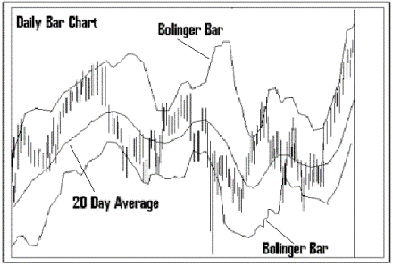This technique developed by John Bollinger places two trading bands around a moving average, as is somewhat similar to the envelope technique. However, the Bollinger Bands are placed two standard deviations above and below the moving average, which is usually a 20-day average. What is a standard deviation? It's a statistical concept that describes how prices are dispersed around an average value. When Bollinger Bands are used, it ensures that 95% of the price data will fall within the two trading bands. On the upside, prices are considered to be overextended (overbought) when the prices touch the upper band, and oversold on the downside when they touch the lower band. Below is a rough graph of how a set of Bollinger Bands might look when applied to a 20-day average.

Bollinger Bands are easiest used as price targets. Simply put, if prices bounce off the lower band and cross above the 20-day average, the upper band becomes the upper target price. Prices crossing below the 20-day average would mark the lower band as the downside target. Because prices usually fluctuate between the 20-day average and the upper band in a strong uptrend, a cross below the average would warn of a trend reversal to the downside.
The placement of Bollinger Bands is based on the last 20-days volatility rather than a constant percentage like envelopes. During periods of rising volatility, the distance between the two bands widens. During periods of low volatility, naturally, the distance between the bands contracts. The general tendency is for bands to alternate between expansion and contraction. our stock trader takes it as a sign the current trend may be ending when the bands are unusually far apart. He looks for the market to initiate a new trend when the bands have narrowed too far. Bollinger Bands can be altered to work with weekly and monthly charts by using 20 weeks and 20 months instead of 20 days, and they work best when combined with overbought/oversold oscillators.
Andy Swan is co-founder and head trader for DaytradeTeam.com. To get all of Andy's day trading, swing trading, and options trading alerts in real time, subscribe to a one-week, all-inclusive trial membership to DaytradeTeam by clicking here.